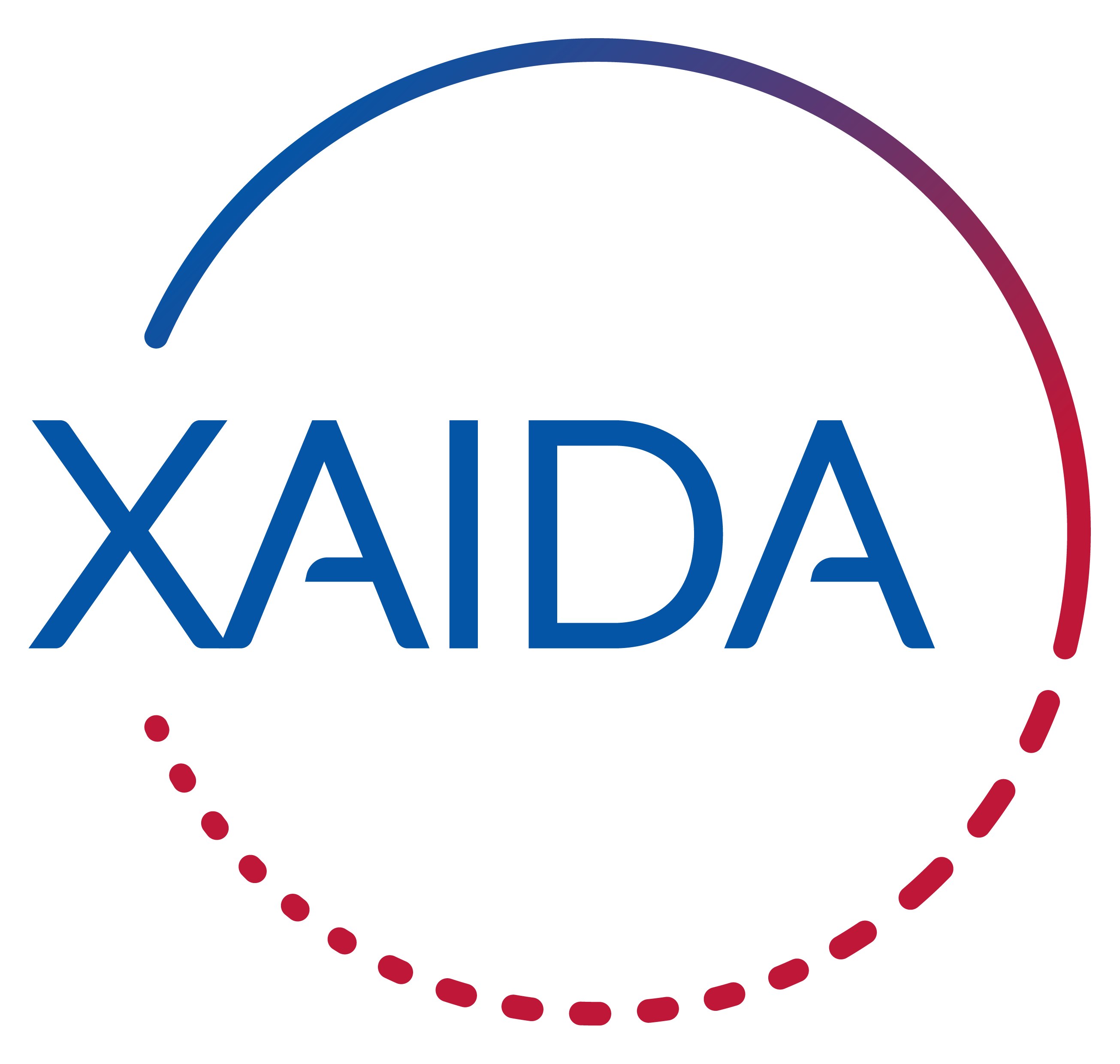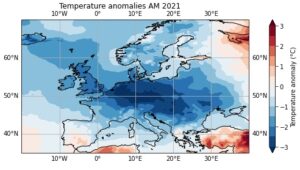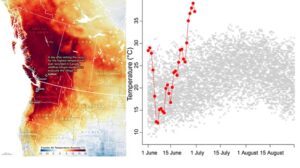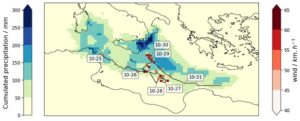Combined cold spell and wind drought winters
Winter cold spells in Europe can be accompanied by anomalously weak winds. Usually, the reason is a so-called “blocked” atmospheric circulation, leading to advection of cold air downstream and a weaker than normal warming westerly flow. This creates a situation where energy demand is high, but power production from renewables is low, leading to higher risk of energy shortfall (Figure 1). With the transition towards more renewable energies in Europe, the energy sector will also become more weather-dependent, making it necessary to understand potential changes in the frequency and intensity of combined cold/wind drought winters.

Figure1: Simulated change in European energy production, demand, and the resulting shortfall, for different atmospheric circulation regimes. The “blocked” regimes of NAO- and Sc. Bl. are seen to both reduce production (due to weaker winds over northern Europe) and increase demand (due to colder temperatures). From van der Wiel et al. (2019 Env. Res. Lett., https://doi.org/10.1088/1748-9326/ab38d3).
Event definition
XAIDA suggests to adopt a “compound event” perspective. There are several options for metrics of compound events:
- Option 1: During the last stakeholder meeting, it appeared possible to simulate energy demand/production through some “cheap” models that use climate conditions (e.g. large ensembles) as input. Such simulations would allow for identifying wind and temperature combinations (i.e. compound events) associated with energy shortfalls. The latter could be defined as the difference of production and demand.
- Option 2: Similar to the above, but based on observed wind-temperature and energy data (if data is available).
- Option 3: Build on single extreme energy shortfalls that have occurred in the past and use the anomalies associated with such events as a single compound event of interest (e.g. for attribution etc).
- Option 4: Define the compound event as low wind and temperature via thresholds identified based on expert knowledge of the energy modellers.
Discussion with stakeholders is expected to identify the best option.
Objectives
XAIDA aims at improving the understanding of the occurrence and the impacts of these events. This seems particularly relevant given the increasing importance of renewables in the energy market.
Moreover, XAIDA aims to assess how these might change in frequency in the future. For this aspect, XAIDA aims to understand the driving physical mechanisms of this event, by using methods from causal inference.
Study results
The investigation started by identifying characteristics of the different energy days defined earlier. This highlighted a significant decreasing trend of energy demand days due to the increase in winter time temperatures. Similarly, a decreasing trend is also observed for energy shortfall days, however this decrease is only significant for half of the countries. Countries with high installed wind capacity, or southern countries with warmer climates, have shortfall days that coincide more with wind days, while countries with low installed wind capacity, or northern countries with colder climates, have shortfall days that coincide more with demand days. As countries will be increasing their proportion of renewable energy, and therefore installed wind capacity, the relative influence of high demand and low wind days on high shortfall days might, as a consequence, evolve (Bloomfield et al., 2018).
Investigating the characteristics of energy events (consecutive energy days) depending on their duration showed that longer shortfall events also had higher shortfall, which is linked to generally lower temperatures experienced during longer shortfall events. Thus these events are particularly critical to the energy network.
In a second step, the influence of six weather regimes on the identified energy days was studied. A first important observation shows that some regimes, mostly blocking-type regimes (Atlantic Ridge, Scandinavian Blocking, negative North Atlantic Oscillation), favour the occurrence of shortfall days across most of Europe. Across the Mediterranean basin, shortfall days are favoured during the Scandinavian Trough regime. These results are consistent with previous studies (Bloomfield et al., 2020a; Grams et al., 2017; van der Wiel et al., 2019b). Further analysis showed that some regimes affect multiple countries over large parts of Europe, suggesting that shortfall days can occur simultaneously for multiple countries, putting many national energy networks under stress. By further investigating this hypothesis, this study shows that if countries that are part of a Regional Security Coordinator experience coinciding shortfall days, the closest neighbouring countries are likely to also experience shortfall days at the same time. This underlines that, while increasing connections with neighbouring countries is generally beneficial, extending these connections to more distant countries and increasing energy storage capacity would help mitigate these scenarios. Again, these scenarios are favoured by blocking-type regimes.
Finally, a case study was performed looking at the coldest winter of the 20th century in Europe. The aim is to determine a worst case scenario, characterised by extremely persistent blocking regimes (Hirschi & Sinha, 2007; Greatbatch et al., 2015), that could be experienced by the current energy network. We show that most European countries would experience higher than normal demand and shortfall, with an increased frequency of both demand and shortfall days for all countries. Similar winters are unlikely but not impossible (Sippel et al., 2024), therefore an energy network more reliant on renewable energy sources needs to be prepared to weather these possible situations.
Conclusion
This study highlights how weather regimes impact countries differently, but also how their characteristic large spatial scale and temporal persistence can put large parts of Europe’s energy network under intense strain.
References
Bloomfield, H. C., Brayshaw, D. J., Shaffrey, L. C., Coker, P. J., & Thornton, H. E. (2018). The changing sensitivity of power systems to meteorological drivers: A case study of Great Britain. Environmental Research Letters, 13(5). https://doi.org/10.1088/1748-9326/aabff9
Bloomfield, H. C., Brayshaw, D. J., & Charlton-Perez, A. J. (2020a). Characterizing the winter meteorological drivers of the European electricity system using targeted circulation types. Meteorological Applications, 27(1). https://doi.org/10.1002/met.1858
Bloomfield, H. C., Brayshaw, D. J. and Charlton-Perez, A. J. (2020b): ERA5 derived time series of European country-aggregate electricity demand, wind power generation and solar power generation: hourly data from 1979-2019. University of Reading. Dataset. https://doi.org/10.17864/1947.272
Grams, C. M., Beerli, R., Pfenninger, S., Staffell, I., & Wernli, H. (2017). Balancing Europe’s wind-power output through spatial deployment informed by weather regimes. Nature Climate Change, 7(8), 557–562. https://doi.org/10.1038/NCLIMATE3338
Otero, N., Martius, O., Allen, S., Bloomfield, H., & Schaefli, B. (2022). Characterizing renewable energy compound events across Europe using a logistic regression-based approach. Meteorological Applications, 29(5). https://doi.org/10.1002/met.2089
Sippel, S., Barnes, C., Cadiou, C., Fischer, E., Kew, S., Kretschmer, M., … & Yiou, P. (2024). Could an extremely cold central European winter such as 1963 happen again despite climate change? Wea. Clim. Dyn., 5, 943–957.
Van der Wiel, K., Bloomfield, H. C., Lee, R. W., Stoop, L. P., Blackport, R., Screen, J. A., & Selten, F. M. (2019b). The influence of weather regimes on European renewable energy production and demand. Environmental Research Letters, 14(9). https://doi.org/10.1088/1748-9326/ab38d3
 This project has received funding from the European Union’s Horizon 2020 research and innovation programme under grant agreement No 101003469.
This project has received funding from the European Union’s Horizon 2020 research and innovation programme under grant agreement No 101003469.



